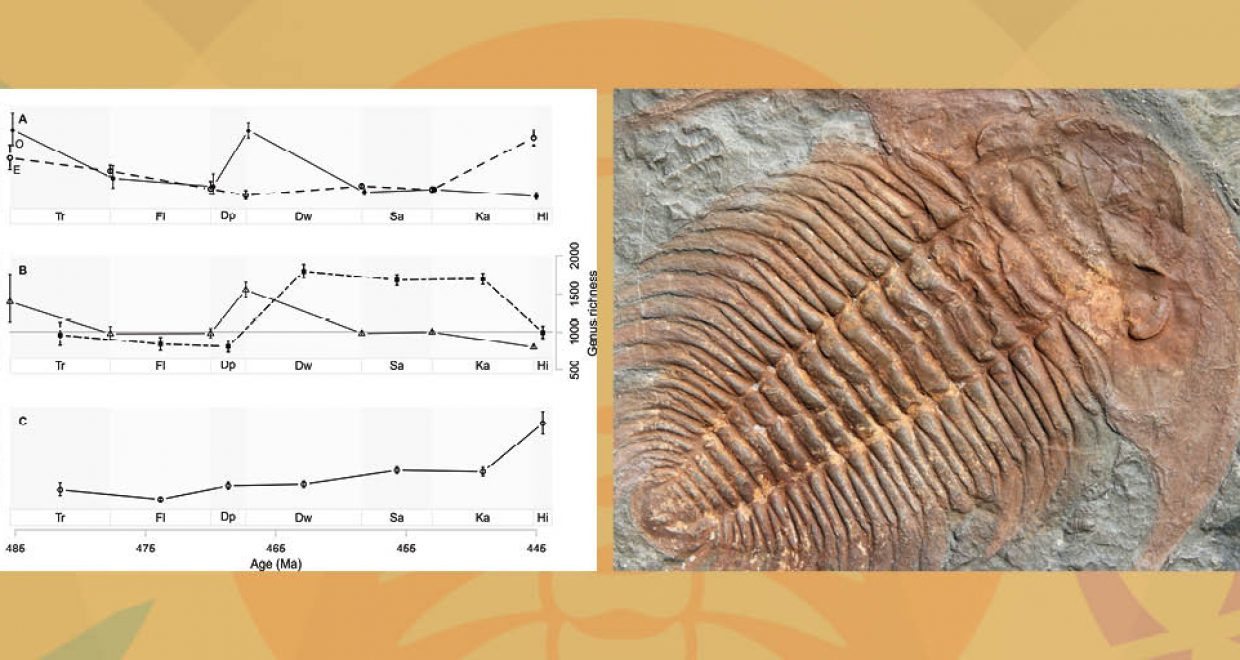Dynamics behind life’s supernova in the Ordovician
Studying how biodiversity on our planet has developed through time and how it reacted to environmental changes would be relatively straight-forward if we could time-travel, as ecologists. However, time-travelling is still far-fetched. One of the best ways to explore deep time biodiversity is studying the rock record and fossils therein.
Fossils from the Ordovician c. 485 to 443 million years ago reveal one of the most dramatic increases in biodiversity our planet has ever seen. In less than six million years, global genus richness doubled from c. 900 to c. 1900 genera. While this may not sound terribly impressive, remember these numbers refer only to those marine organisms that have decent fossil records. This increase was so great and fast that scientists named it the Great Ordovician Biodiversification Event (GOBE).
What caused the GOBE? To come up with sensible hypotheses, we need details of how the GOBE unfolded: biodiversity is the result of the balance of species coming into being and others dropping out of existence. These two components may be affected by different environmental and/or biological factors.
In our newly published study, we analyzed global taxon richness, but also richness on different paleocontinents and paleoenvironments (shallow and deep water). Investigating dynamics of diversification on different scales (global, regional) and in varied environments enable us to improve our understanding of the variation in the timing, and hence potential triggers, of GOBE.
We found that the paleocontinent Laurentia (now mostly North America) had lower origination and extinction rates than Baltica (Baltic States, parts of western Russia and Scandinavia). This may be due to Baltica experiencing more environmental change as it rotated from southern mid-latitudes northwards towards the equator during the Ordovician. Laurentia, on the other hand, was quite stationary for the same time period. The dramatic increase in biodiversity during the Middle Ordovician c. 469 to 463 million years ago was due to a dramatic increase of origination rates, rather than a dampening of extinction rates. Our comparison of extinction and origination rates in shallow and deep water led us to the conclusion that temporal changes in diversification rates were not different within these environments, raising the possibility that drivers of the GOBE are also the same.
Our study was based on the data compiled by many, many paleontologists. Our colleagues have painstakingly worked on many different outcrops, collected fossils, identified them, published their findings and compiled them in a large open-access database (The Paleobiology Database). These amazing data allowed us to model origination, extinction and sampling rates simultaneously, using statistical methods (capture-recapture approaches) first developed by ecologists interested in population dynamics.
Our study shows that the GOBE was characterized by an increase origination rates that appeared to have been temporally synchronized on different continents and clades, which suggests a large-scale, global driver behind the GOBE. However, the nature of this global trigger remains a mystery.
“Dissecting the paleocontinental and paleoenvironmental dynamics of the great Ordovician biodiversification” by Franziska Franeck, Lee Hsiang Liow is the featured paper in the May 2019 issue of Paleobiology. The full article, published Open Access, can be found here.
Images: Left – Figure 1: Global genus diversification and genus diversity dynamics from https://doi.org/10.1017/pab.2019.4 . Right – Fossil of a trilobites from the early ordovician period found in Czech Republic © siloto /shutterstock
Read other blog posts from Paleobiology here.
or view all blog posts from the Paleontological Society Journals






